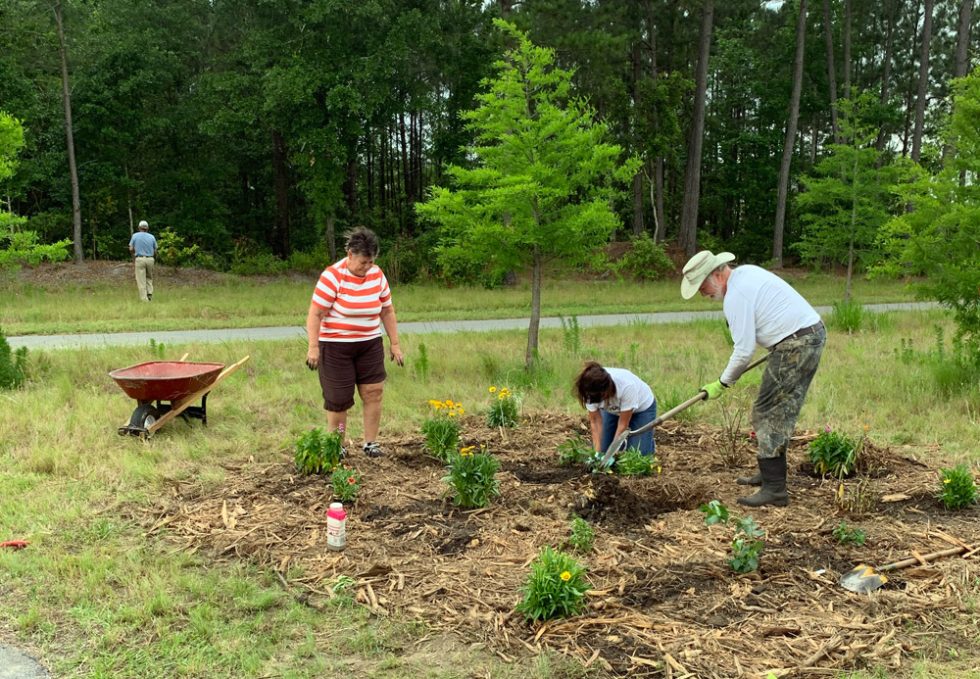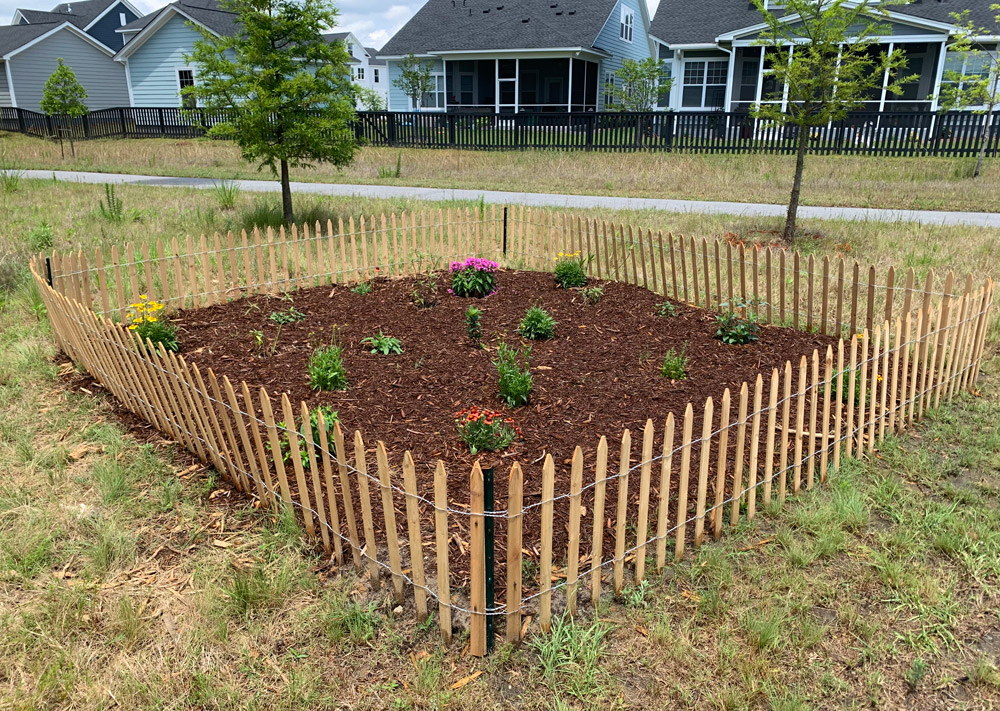
Birds, Bees & Butterflies: Our Newest Neighbors
May 21st, 2020
In addition to nurturing their own backyard gardens this spring, some Carnes Crossroads residents have spent their extra time at home initiating new projects that support nature in our community and will enhance our neighborhoods for years to come.
Carnes Crossroads resident John Foehl, an enthusiastic nature lover who is fascinated with birds and loves to be outside, was behind two such ideas. But it was the support a hard-working team of resident volunteers who came together that actually brought these ideas to life at Carnes Crossroads.
Homes for Bluebirds
“After moving to Carnes, my wife Linda and I noticed there were numerous bluebirds that frequented the woodline behind our house,” John explains. “We’ve seen bluebird boxes in other neighborhoods and after seeing the birds here we thought it was an idea the neighbors at Carnes Crossroads might embrace.”
Like many songbirds, bluebirds are under stress from the disappearance of their habitat. The idea of trying to encourage the pairs the Foehls observed behind their home to nest within the neighborhoods here made perfect sense. He took the idea up with fellow neighbor Judie Edwards, who immediately got behind it. Before long, resident volunteers were mounting 20 bluebird boxes in trees throughout the neighborhood.
“Hopefully, by next year we’ll have bluebirds nesting in the boxes, but the nice thing is they also make great homes for barn swallows, chickadees and titmouses as well, all birds that are beneficial to have here in our neighborhoods,” John says.
Support For Local Honey Bees
But the Foehls didn’t stop with bluebirds. John and Linda recently added pollinator gardens to their back yard to attract butterflies and support the local honey bee population, which is under heavy stress.
“Without bees so much of our fruit, vegetable and flowers would cease to exist, so it’s important for communities to work towards supporting our bee population,” says John.
On their daily walks along the Carnes trails, it was easy for the Foehls to visualize transforming the trails by adding wildflowers that would attract bees. John did some research and came across the Mayors Monarch Pledge website. The Mayors Monarch Pledge is an initiative of the National Wildlife Federation that encourages U.S. cities and municipalities to create habitats for the monarch butterfly and pollinators, and to educate citizens about how they can make a difference in their community.
Working again with the Neighborhood Association, John and Linda recruited volunteers who helped plant and are helping maintain two pollinator gardens along one of the neighborhood trails. Funding from the Carnes Crossroads Property Owners association covered the costs of native perennials like Monarda (bee balm), Joe Pye Weed, Coreopsis, Phlox, Stokesia Aster and Asclepieas (milkweed). Within a couple of years the gardens should be full of low-maintenance flowers, so they’ll continue to support bees well into the future.
“Eventually we can apply to have the gardens certified as part of the Monarch Pollinator Garden group and also as a Certified Wildlife Habitat,” John says. “We hope to accomplish this by late summer. From there it would be nice to continue to add gardens to community spaces as the community grows.”
In fact, residents are working towards expanding both initiatives next spring. Meanwhile, John and his neighbors aren’t finished brainstorming ideas for helping enhance our neighborhoods and parks.
“We’ve initiated the idea of starting a commemorative bench project, with the Property Owners’ Association,” he says. “Community members can buy outdoor benches that will be installed around the trail system. The benches can have engraved plaques commemorating people the donors want to recognize.”
With ideas like these in place, it’s easy to envision generations of Carnes Crossroads residents strolling along the trails and stopping to sit and enjoy the flowers, butterflies and bees that have found a home in our community.


 © 2024. All rights reserved. Materials are protected by copyright, trademark, and other intellectual property laws. All rights in these materials are reserved. All products and company names marked as trademarked(™) or registered (®) are trademarks of their respective holders. Copying, reproduction and distribution of materials without prior written consent of Freehold Communities® is strictly prohibited. Obtain the property report required by federal law and read it before signing anything. No federal or state agency has judged the merits or value, if any, of this property. This information does not represent a specific offer of sale or solicitation to purchase property within Carnes Crossroads. All information, plans, renderings, conceptual maps, and pricing are subject to change without notice. Prospective purchasers and existing homeowners are expected to and should make their own conclusions without reliance upon provided materials and conduct their own research prior to purchasing real estate or electing to participate in any amenity offerings in Carnes Crossroads. Images do not reflect racial preference.
© 2024. All rights reserved. Materials are protected by copyright, trademark, and other intellectual property laws. All rights in these materials are reserved. All products and company names marked as trademarked(™) or registered (®) are trademarks of their respective holders. Copying, reproduction and distribution of materials without prior written consent of Freehold Communities® is strictly prohibited. Obtain the property report required by federal law and read it before signing anything. No federal or state agency has judged the merits or value, if any, of this property. This information does not represent a specific offer of sale or solicitation to purchase property within Carnes Crossroads. All information, plans, renderings, conceptual maps, and pricing are subject to change without notice. Prospective purchasers and existing homeowners are expected to and should make their own conclusions without reliance upon provided materials and conduct their own research prior to purchasing real estate or electing to participate in any amenity offerings in Carnes Crossroads. Images do not reflect racial preference. 